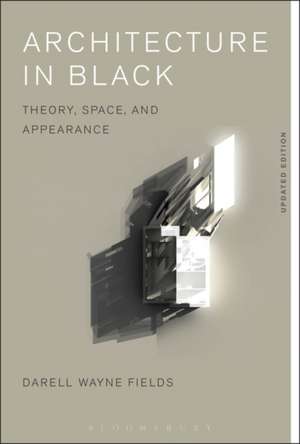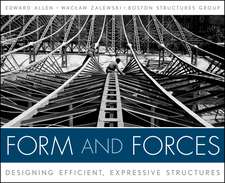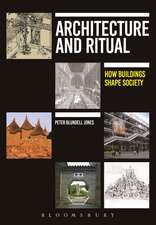Architecture in Black: Theory, Space and Appearance
Autor Darell Wayne Fieldsen Limba Engleză Paperback – 21 sep 2016
| Toate formatele și edițiile | Preț | Express |
|---|---|---|
| Paperback (1) | 256.85 lei 6-8 săpt. | |
| Bloomsbury Publishing – 21 sep 2016 | 256.85 lei 6-8 săpt. | |
| Hardback (1) | 1156.11 lei 6-8 săpt. | |
| Bloomsbury Publishing – 3 ian 2000 | 1156.11 lei 6-8 săpt. |
Preț: 256.85 lei
Preț vechi: 330.84 lei
-22% Nou
Puncte Express: 385
Preț estimativ în valută:
49.15€ • 51.42$ • 40.83£
49.15€ • 51.42$ • 40.83£
Carte tipărită la comandă
Livrare economică 03-17 aprilie
Preluare comenzi: 021 569.72.76
Specificații
ISBN-13: 9781350009875
ISBN-10: 1350009873
Pagini: 232
Dimensiuni: 156 x 234 x 17 mm
Greutate: 0.33 kg
Ediția:NIPPOD
Editura: Bloomsbury Publishing
Colecția Bloomsbury Academic
Locul publicării:London, United Kingdom
ISBN-10: 1350009873
Pagini: 232
Dimensiuni: 156 x 234 x 17 mm
Greutate: 0.33 kg
Ediția:NIPPOD
Editura: Bloomsbury Publishing
Colecția Bloomsbury Academic
Locul publicării:London, United Kingdom
Caracteristici
Draws on work by Claude Lévi Strauss, Étienne-Louis Boullée, Claude-Nicolas Ledoux, Lebbeus Woods, John Hejduk and Peter Eisenman
Notă biografică
Darell Wayne Fields is a Lecturer in the College of Environmental Design at the University of California, Berkeley, USA.
Cuprins
List of IllustrationsAcknowledgementsIntroduction to Second Edition ForewordPART I: THEORYForethought: On Blackness and TimeIntroduction to Part I 1. Hegel's Tropes: History, Architecture and the Black SubjectPhilosophy and Aesthetics: A Total Model of HistoryThe Subject IdentifiedFull Force of the Effect: The Negation of the Black SubjectThe Symbolic Category: Architecture's BlacknessTranscending the Black Subject2. Scheming the Scheme: The Technique of RevisionA Racial Model of the DialecticThe Consistency of IdeasA Comprehensive DiagramA Linguistic Revision of AestheticsReintroduction of the Black Subject3. Tropological Cases: the Racial Object in Architectural DiscourseSignification of the First Order: Laws of EmergenceCase 1: An Original Essay on StyleCase 2: A Reflective Essay on StyleCase 3: A Philosophical Essay on StyleSignification of the Second Order: Operations on a Black SignifierContemporary Architectural Theory: Talking BlackAfterthoughtA Monkey Reading ... FanonPART II: ORDERS OF SPACE AND APPEARANCEForethought: The Negative ConstructsIntroduction to Part II 4. Black AutonomyThe Classical (P)eriodSpace and Time: Kant and the IndivisibleThe Medieval as Symbolic: An Other Space, Another TimeKant, Blackness and Autonomy: Towards a Black Formalism5. Space and Time in the Classical (P)eriodFrom Space to AppearanceSpatial Orders in the Birth of TragedyVisualizing Autonomy: A Reflection on a History of StylesThe Spatial Diagrammatic 6. Architecture and the Classical (P)eriodBuilding on Language: Black ArchitectonicsSpatial Linguistics and the Hall of MirrorsThe Black Architectonic: A Methodological NoteNow Imagine a Monkey Sitting in a Dark Place Trying to See Architecture for the First Time Étienne-Louis Boullée (1728-1799) Claude-Nicolas Ledoux (1736-1806) Lebbeus Woods (1940-2012) John Hejduk (1929-2000) Darell Fields (1962-)AfterthoughtThe End: Of AbsenceWorks CitedIndex
Recenzii
Darell Field's pioneering book is the first theoretical treatment of race in architecural discourse. The first mature attempt to engage in a sophisticated theoretical discourse about architecture and race using the tools of cultural studies and Afro-American literary theory. In this way, Fields has opened new critical and constructive possibilities for our intellectual discussions of modernity, architecture, and race.
Emerging from a context in which architectural theory increasingly avoids difficult questions, Architecture in Black engages them in a distinctive way. Beginning with a rereading of Hegel's Aesthetics and The Philosophy of History, Fields conjures an encounter between architectural theory and semiotic structures that mines the gaps of history to reconstruct the black subject in a manner that is diagrammatic, projective, and defiantly autonomous and unfixed. Interrogating both history and dialectics to unveil alternative realities, this is an important contribution to the exploration of aporias in architectural theory.
A bold and invigorating discussion of the intersection between architecture and race. By excavating the racialized history of architecture, the book opens up new territories for a wider interdisciplinary debate and discussion. An enormously important book.
It is best to think of this text as an allegorical demonstration of its central thesis: using the critical tools of semiotics, Darell Fields uncovers the black subjectivities hidden with the architectonic structures of Continental Philosophy. Working as the fabled 'trickster' of old, Fields cleverly uses his prose to revise the critical aims of philosophy by constructing a new world from its multiple fragments. While both serious and critical in tone, Architecture in Black is delightfully irreverent in its transformation of the very system it relies upon for existence. The results are both haunting and revelatory. The disembodied voice of its 'Black Subject' is freed of its nineteenth-century prison in time to exert its will upon the projective logic of contemporary architecture.
Emerging from a context in which architectural theory increasingly avoids difficult questions, Architecture in Black engages them in a distinctive way. Beginning with a rereading of Hegel's Aesthetics and The Philosophy of History, Fields conjures an encounter between architectural theory and semiotic structures that mines the gaps of history to reconstruct the black subject in a manner that is diagrammatic, projective, and defiantly autonomous and unfixed. Interrogating both history and dialectics to unveil alternative realities, this is an important contribution to the exploration of aporias in architectural theory.
A bold and invigorating discussion of the intersection between architecture and race. By excavating the racialized history of architecture, the book opens up new territories for a wider interdisciplinary debate and discussion. An enormously important book.
It is best to think of this text as an allegorical demonstration of its central thesis: using the critical tools of semiotics, Darell Fields uncovers the black subjectivities hidden with the architectonic structures of Continental Philosophy. Working as the fabled 'trickster' of old, Fields cleverly uses his prose to revise the critical aims of philosophy by constructing a new world from its multiple fragments. While both serious and critical in tone, Architecture in Black is delightfully irreverent in its transformation of the very system it relies upon for existence. The results are both haunting and revelatory. The disembodied voice of its 'Black Subject' is freed of its nineteenth-century prison in time to exert its will upon the projective logic of contemporary architecture.















